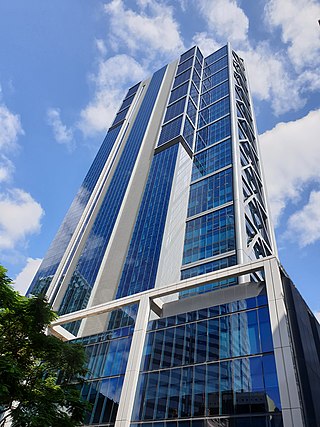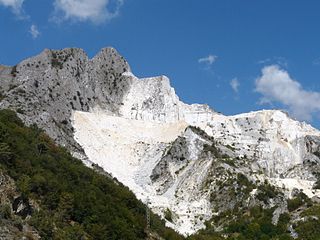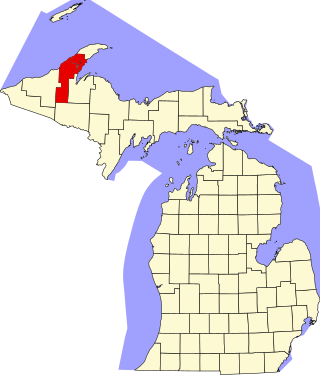
Mining is the extraction of valuable geological materials and minerals from the surface of the Earth. Mining is required to obtain most materials that cannot be grown through agricultural processes, or feasibly created artificially in a laboratory or factory. Ores recovered by mining include metals, coal, oil shale, gemstones, limestone, chalk, dimension stone, rock salt, potash, gravel, and clay. The ore must be a rock or mineral that contains valuable constituent, can be extracted or mined and sold for profit. Mining in a wider sense includes extraction of any non-renewable resource such as petroleum, natural gas, or even water.

The Northwest Territories is a federal territory of Canada. At a land area of approximately 1,144,000 km2 (442,000 sq mi) and a 2016 census population of 41,790, it is the second-largest and the most populous of the three territories in Northern Canada. Its estimated population as of 2023 is 45,668. Yellowknife is the capital, most populous community, and only city in the territory; its population was 19,569 as of the 2016 census. It became the territorial capital in 1967, following recommendations by the Carrothers Commission.

A naval mine is a self-contained explosive device placed in water to damage or destroy surface ships or submarines. Unlike depth charges, mines are deposited and left to wait until they are triggered by the approach of, or contact with, any vessel or a particular vessel type, akin to anti-infantry or anti-vehicle mines. Naval mines can be used offensively, to hamper enemy shipping movements or lock vessels into a harbour; or defensively, to protect friendly vessels and create "safe" zones. Mines allow the minelaying force commander to concentrate warships or defensive assets in mine-free areas giving the adversary three choices: undertake an expensive and time-consuming minesweeping effort, accept the casualties of challenging the minefield, or use the unmined waters where the greatest concentration of enemy firepower will be encountered.

BHP Group Limited is an Australian multinational mining and metals public company headquartered in Melbourne, Victoria, Australia.

A quarry is a type of open-pit mine in which dimension stone, rock, construction aggregate, riprap, sand, gravel, or slate is excavated from the ground. The operation of quarries is regulated in some jurisdictions to manage their safety risks and reduce their environmental impact.

Coal mining is the process of extracting coal from the ground or from a mine. Coal is valued for its energy content and since the 1880s has been widely used to generate electricity. Steel and cement industries use coal as a fuel for extraction of iron from iron ore and for cement production. In the United Kingdom and South Africa, a coal mine and its structures are a colliery, a coal mine is called a "pit", and above-ground mining structures are referred to as a "pit head". In Australia, "colliery" generally refers to an underground coal mine.

Open-pit mining, also known as open-cast or open-cut mining and in larger contexts mega-mining, is a surface mining technique of extracting rock or minerals from the earth from an open-air pit, sometimes known as a borrow.

A minesweeper is a small warship designed to remove or detonate naval mines. Using various mechanisms intended to counter the threat posed by naval mines, minesweepers keep waterways clear for safe shipping.

"Sweet Child o' Mine" is a song by American rock band Guns N' Roses, released on their debut studio album, Appetite for Destruction (1987). In the United States, the song was released on June 21, 1988 as the album's first single, topping the US Billboard Hot 100 chart and becoming the band's only US number-one single. In the United Kingdom, the song was released in August 1988, reaching number 24 on the UK Singles Chart the same month. Re-released there in May 1989, it peaked at number six.

A minelayer is any warship, submarine, military aircraft or land vehicle deploying explosive mines. Since World War I the term "minelayer" refers specifically to a naval ship used for deploying naval mines. "Mine planting" was the term for installing controlled mines at predetermined positions in connection with coastal fortifications or harbor approaches that would be detonated by shore control when a ship was fixed as being within the mine's effective range.

Rio Tinto Group is a British-Australian multinational company that is the world's second largest metals and mining corporation. It was founded in 1873 when a group of investors purchased a mine complex on the Rio Tinto, in Huelva, Spain, from the Spanish government. It has grown through a long series of mergers and acquisitions. Although primarily focused on extraction of minerals, it also has significant operations in refining, particularly the refining of bauxite and iron ore. It has joint head offices in London, England and Melbourne, Australia.

Golconda is a fortified citadel and ruined city located in the western outskirts of Hyderabad, Telangana, India. The fort was originally built by Kakatiya ruler Pratāparudra in the 11th century out of mud walls. It was ceded to the Bahmani Kings from Musunuri Nayakas during the reign of the Bahmani Sultan Mohammed Shah I, during the first Bahmani-Vijayanagar War. Following the death of Sultan Mahmood Shah, the Sultanate disintegrated and Sultan Quli, who had been appointed as the Governor of Hyderabad by the Bahmani Kings, fortified city and made it the capital of the Golconda Sultanate. Because of the vicinity of diamond mines, especially Kollur Mine, Golconda flourished as a trade centre of large diamonds known as Golconda Diamonds. Golconda fort is currently abandoned and in ruins. The complex was put by UNESCO on its "tentative list" to become a World Heritage Site in 2014, with others in the region, under the name Monuments and Forts of the Deccan Sultanate.
The following is a list of Registered Historic Places in Iron County, Michigan. The list includes 79 structures and historic districts that are significant for their architectural, historical, or industrial/economic importance.

This is a list of the National Register of Historic Places listings in Houghton County, Michigan.

Coal India Limited (CIL) is an Indian central public sector undertaking under the ownership of the Ministry of Coal, Government of India. It is headquartered at Kolkata. It is the largest government-owned-coal-producer in the world. It is also the ninth largest employer in India with nearly 272,000 employees.

The Lake Vermilion-Soudan Underground Mine State Park is a Minnesota state park at the site of the Soudan Underground Mine, on the south shore of Lake Vermilion, in the Vermilion Range (Minnesota). The mine is known as Minnesota's oldest, deepest, and richest iron mine. It formerly hosted the Soudan Underground Laboratory. As the Soudan Iron Mine, it has been designated a U.S. National Historic Landmark.

The Wieliczka Salt Mine is a salt mine in the town of Wieliczka, near Kraków in southern Poland.

Beaver Mines is a hamlet in southern Alberta, Canada within the Municipal District of Pincher Creek No. 9. It is located in the foothills of the Canadian Rockies on Highway 507, approximately 19 km (12 mi) west of Pincher Creek.
















